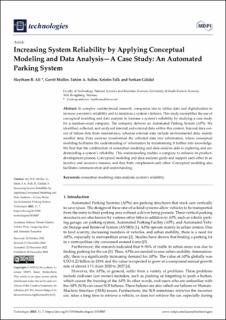| dc.contributor.author | Ali, Haytham | |
| dc.contributor.author | Muller, Gerrit | |
| dc.contributor.author | Salim, Fahim Ahmed | |
| dc.contributor.author | Falk, Kristin | |
| dc.contributor.author | Güldal, Serkan | |
| dc.date.accessioned | 2023-04-28T11:32:35Z | |
| dc.date.available | 2023-04-28T11:32:35Z | |
| dc.date.created | 2022-12-28T15:05:35Z | |
| dc.date.issued | 2022 | |
| dc.identifier.citation | Ali, H. B., Muller, G., Salim, F. A., Falk, K. & Güldal, S. (2023). Increasing System Reliability by Applying Conceptual Modeling and Data Analysis—A Case Study: An Automated Parking System. Technologies, 11(1), Artikkel 7. | en_US |
| dc.identifier.issn | 2227-7080 | |
| dc.identifier.uri | https://hdl.handle.net/11250/3065544 | |
| dc.description.abstract | In complex sociotechnical research, companies aim to utilize data and digitalization to increase a system’s reliability and to minimize a system’s failures. This study exemplifies the use of conceptual modeling and data analysis to increase a system’s reliability by studying a case study for a medium-sized company. The company delivers an Automated Parking System (APS). We identified, collected, and analyzed internal and external data within this context. Internal data consist of failure data from maintenance, whereas external data include environmental data, mainly weather data. Data analyses transformed the collected data into information, where conceptual modeling facilitates the understanding of information by transforming it further into knowledge. We find that the combination of conceptual modeling and data analysis aids in exploring and understanding a system’s reliability. This understanding enables a company to enhance its product-development process. Conceptual modeling and data analyses guide and support each other in an iterative and recursive manner, and they both complement each other. Conceptual modeling also facilitates communication and understanding. | en_US |
| dc.language.iso | eng | en_US |
| dc.rights | Navngivelse 4.0 Internasjonal | * |
| dc.rights.uri | http://creativecommons.org/licenses/by/4.0/deed.no | * |
| dc.title | Increasing System Reliability by Applying Conceptual Modeling and Data Analysis—A Case Study: An Automated Parking System | en_US |
| dc.type | Peer reviewed | en_US |
| dc.type | Journal article | en_US |
| dc.description.version | publishedVersion | en_US |
| dc.rights.holder | © 2022 by the authors. | en_US |
| dc.source.volume | 11 | en_US |
| dc.source.journal | Technologies | en_US |
| dc.source.issue | 1 | en_US |
| dc.identifier.doi | https://doi.org/10.3390/technologies11010007 | |
| dc.identifier.cristin | 2097810 | |
| dc.source.articlenumber | 7 | en_US |
| cristin.ispublished | true | |
| cristin.fulltext | original | |
| cristin.qualitycode | 1 | |

